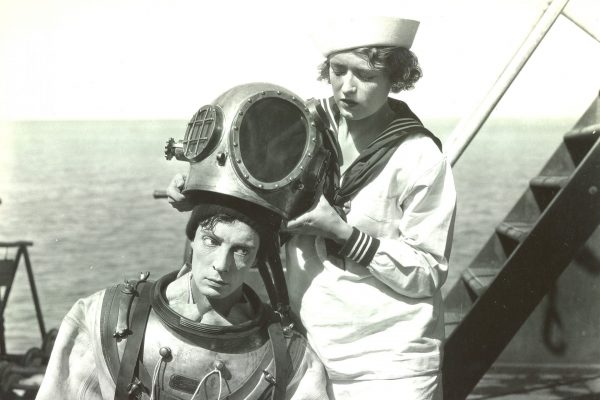Buster Keaton/USA/ 1924-1926/ 198 minutes.
The three films in this collection all centre on Buster Keaton’s characters falling in love: and while there are often “happy” endings for Keaton and his romantic partner, do we really think that after the film ends Keaton will settle down for a hassle free life? It seems unlikely to say the least.
The Navigator, often acclaimed as one of Keaton’s greatest pictures, co-directed with Donald Crisp, is a game of two halves. But the first is virtuosic indeed: Keaton is Rollo Treadway, a pearly aristocrat (mocked by sarcastic inter-titles), who on a whim asks his neighbour Betsy (Kathryn McGuire) to marry him. Being coddled, and expecting an affirmation in response, he organises the honeymoon before she’s had a chance to reply. She declines, and he, dejected, boards a ship alone. Owing to some naval subterfuge, he has just boarded the wrong ship, about to be set adrift in the Pacific with no capability of being piloted. Caught up in the chaos, Betsy ends up on the boat too, and it glides aimlessly across the endless ocean.
As Rollo and Betsy become aware that there’s someone else on the Navigator, the directors stage the film’s outstanding set-piece, an example of what film-philosopher Nöel Carroll calls a mutual interference gag, as both participants misunderstand the situation while the audience comprehends exactly: here, the camera is stationed on the ship’s bow looking at the forecastle as Betsy and Rollo chase after each other, avoiding the other’s gaze by seconds every time, ascending a staircase exactly as the other descends. The joke is in the shot’s absurd duration and therefore becomes about both the characters’ and the audience’s frustrated desire to have them reunite. It’s a small miracle of comedic timing. The second half falls into disrepair slightly, excepting a lovely underwater sequence with Rollo in a diver’s suit, using a lobster’s claws as pliers. The latter part of The Navigator imperils the pair by having the ship draw near the shore of an unidentified Pacific Island, whose inhabitants are spear-wielding cannibals. As the invidious racism takes over the movie, the gags lose their interest.
The best of the three films collected here is Seven Chances. Its scenario needs to be taken, not with a pinch, but with a cubic metre of salt. Keaton is Jimmy Shannon, a financial broker. He’s in a tentative relationship with Mary (Ruth Dwyer): tentative because Jimmy, although he does love her, can’t quite work up the courage to tell her. He receives a missive from his grandfather, informing him that he’ll inherit the sum of $7 million if he marries on the evening of 27th birthday: which is the day he reads the letter. He and his business partner start arrangements, but his proposal to Mary collapses, his words coming out in a mess. After a set of gentle and genteel hijinks in a country club, trying to convince one of the club’s women members to marry him, his partner advertises the proposition in the town newspaper: setting all hell loose.
Lest it be thought that the misogyny of the set-up goes unaddressed, Jimmy is served his comeuppance at the church. As he lies down for a quick snooze, the church fills up with scores of would-be brides. The film transforms from comedy of manners to slapstick extravaganza, launching into an extended chase sequence of immense velocity. As Jimmy races against the clock to explain the confusion to Mary, the beleaguered women are in ready and furious pursuit: one shot of them advancing towards Jimmy on a railroad track looks like a practice-run for Yeon Sang-ho’s Train to Busan. As Jimmy runs with improbable speed across the terrain, flailing with desperation but keeping on his feet somehow, another slapstick-favourite threat becomes apparent: boulders. The rocks roll down the cliff sides as Jimmy shimmies away from them, Keaton’s exacting movements graceful and panicked: the energy of the film is like nothing else in this collection.
Certainly one of Keaton’s lesser efforts is Battling Butler, based on a hampered and unsatisfying scenario involving Keaton as another indolent well-to-do type (Arthur Butler) who, at the insistence of his father, goes camping in order to prove his fortitude and spirit. His father expects him to go alone, replenishing his inner resources while hunting and cooking for himself. Imagine his exasperation when Arthur’s valet joins him, kitted out with a massive and intricate tent and all the furnishings he could want. And that’s not all that goes awry. Instead of shooting anything, Arthur falls in love with a “mountain girl” (Sally O’Neill). But her brothers don’t approve of the diminutive Arthur, for they want no “weaklings” in the family, so Arthur’s valet informs them that he’s in fact a championship boxer, also called Arthur Butler. It’s not exactly airtight. Despite being one of the inspirations for Martin Scorsese’s Raging Bull, the film’s without much of inspiration in itself; except for a final bout outside the ring, in which Keaton finally unlooses some of the manic energy we know he’s keeping bottled up. Worst of all, Keaton’s quite charmless in Battling Butler.
About Buster Keaton’s lugubrious face many words have been spilt, but none are so neat and precise as James Agee’s, from his lovely essay “Comedy’s Greatest Era.” Keaton, Agee writes, ‘had merely been so hard at work it had never occurred to him that there was anything to smile about.’ Keaton’s films place him in traps that only the quickest movements and snappiest thinking will evade: there’s no time for aspirational things like “happiness.” He’s simply too busy.
Available on Blu-Ray now.
